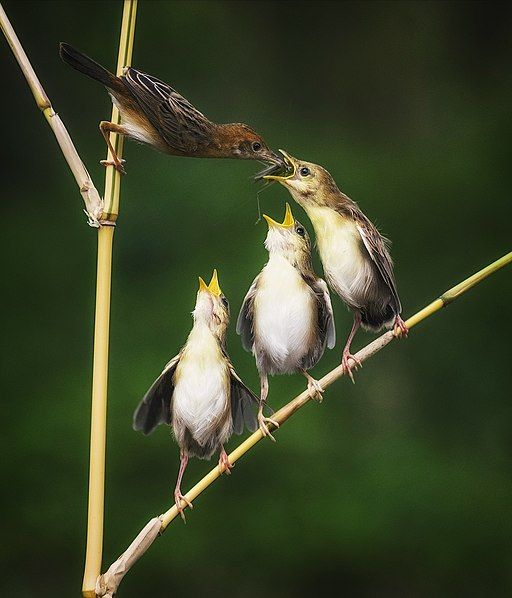Note: This is part two of a three-part series on the finer details of natural selection. Part one can be found here.
In part I of this series we learned about group selection and why it isn't the main driver of evolution in organisms. We also saw that the level of selection determines what kind of altruism we should expect to see in nature.
Individual selection and altruism
We can summarise the relationship between the level of selection and the type of altruism expected as follows:
- Group selection view = survival of the fittest group = groups whose members are altruistic to each other are more likely to survive and reproduce than groups with selfish members.
- Individual selection view = survival of the fittest individual = individuals are mostly selfish, will not sacrifice their time, energy, or resources for the good of the group.
Darwin's view was that the unit of selection was the individual. The fittest individuals survived and passed their genes on to the next generation.
The survival of the fittest individual mostly ends up being the right view. As we saw in part I, the free-rider problem prevents unfettered altruism among group members.
However, more limited forms of altruism can be found in nature. Animals will sometimes help each other if they are genetically related: e.g., their siblings, and sometimes even their cousins. Sometimes they will help each other even if they aren't genetically related: E.g., some species of birds remove parasites from each other's bodies.
There are two mechanisms that can encourage altruism in animals that are otherwise mostly selfish: kin selection and reciprocal altruism.
Kin Selection

Kin selection explains why selfish individuals can care for each other if they are genetically related. The simplest example is of parents caring for their children. This is easily explained – those parents that do everything they can to ensure their children survive are more likely to pass their genes successfully onto the next generation.
But we can find even more complex types of altruism among kin in nature. Birds have been observed helping their nephews. Alarm calls in squirrels seem to be intended to warn kin of the presence of dangers nearby.
Let's try to understand how these altruistic behaviours toward kin come about. Imagine there are three types of behaviours in a species, all controlled by genes:
- AltruisticToNone: organisms with this behaviour type only care for themselves. Siblings don't share food, even if one has too much and the other has little. Parents don't give sufficient care to their young.
- AltruisticToAll: these organisms help everyone around them including their kin.
- AltruisticToKin: these organisms only care for their kin.
AltruisticToKin's genes do the best of the three because they maximise for their own propagation. Organisms with AltruisticToKin benefit their own kin, and they also benefit from the care given to them by the AltruisticToAlls in the population.
It's important to note that AltruisticToKin organisms care about their kin but in a sophisticated way -- according to how genetically related they are. Parents will care for their children, but they will keep in mind that each child only has half the genes of one parent. So helping a child for some discomfort is worth it, but giving up your life for your child might not be. Giving up your life for two children might be worth it (if your children will be able to survive without you), as the cumulative genetic relatedness is 2 * 1/2 = 1. For siblings, giving up your life for 2 of your siblings could be worth it, as 2 * 1/2 = 1. Similarly giving up your life for 8 cousins could be worth it, as on average you share 1/8th of your genes with each cousin and 8 * 1/8 = 1.
I would gladly give up my life for two brothers or eight cousins.
- J. B. S. Haldane
Hamilton's Rule is a more formal way of describing the math natural selection encourages organisms to do whenever they have an opportunity to help a relative:
\[ B \times r > C \]
Where B = benefit to the receiver of the altruism, r = degree of genetic relatedness of the receiver, C is the cost of the action to the altruist.
Put in evolutionary terms, those who help their siblings according to Hamilton's Rule (e.g., by sharing food) are more likely to pass their genes on either directly, or through their siblings. Those that help their siblings too little, or too much, are at an evolutionary disadvantage.
Let's try to understand Hamilton's Rule with a simple example. We'll assume that an organism has to take an action that will end with losing its life and saving the lives of some of its kin, e.g., by drawing a predator towards itself and away from its family.
Let's consider three types of kin altruistic organisms:
- SuperAltruisticToKin: Cares a lot about its kin. Ends up sacrificing its life to save 3 cousins.
- Total genetic material saved = 3 * 1/8 (each cousin shares ~1/8th the organism's genes).
- Total genetic material lost = 1.
- In net = 3 * 1/8 - 1 = -0.625. The organism's altruism has reduced the prevalence of its genes in the gene pool.
- NotSoAltruisticToKin: Refuses to sacrifice its life to save 15 cousins.
- Total genetic material saved = 1.
- Total lost = 15 * 1/8.
- In net = 1 - 15 * 1/8 = -0.875. The organism's selfishness has reduced the prevalence of its genes in the gene pool.
- AltruisticToKin: Is altruistic according to Hamilton's Rule. Sacrifices its life for 9 cousins.
- Total saved = 9 * 1/8 = 1.125.
- Total lost = 1.
- In net = 9 * 1/8 - 1 = 0.125.
So as we can see, only AltruisticToKin's genes increase in prevalence in the gene pool.
Put more informally: The forces of natural selection punish both excessive altruism and excessive selfishness towards kin. They push organisms to the sweet spot that maximises propagation of their genes: to be altruistic according to degrees of genetic relatedness as per Hamilton's Rule.
Reciprocal Altruism
There may be situations where individuals appear to behave altruistically, but they're essentially cases of "you scratch my back, I'll scratch yours", also called reciprocal altruism.
This is the second mechanism for cooperation in the animal kingdom. It does not require genetic relatedness, in fact reciprocal altruism can exist between members of different species.
For reciprocity to be possible among two individuals, they need to: 1/ have repeated contact with each other, 2/ be able to recognise each other when they meet, and 3/ remember how they were treated by the other in the past.
One example of reciprocal altruism is cleaner fish – specialised fish species that remove and eat parasites from bigger fish. The bigger fish don't eat the cleaners even after the cleaning is complete, because they know they will need to come back for another cleaning in the future.
Conclusions
We saw how even with individual selection we can see two forms of altruism in nature: 1/ kin selection, 2/ reciprocal altruism.
But what about humans? In the next post, I'll talk about natural selection and altruism as it applies to our species. While we share the impulses to protect kin and reciprocate the altruism of others, we also seem to have a more complex range of altruistic behaviours than most animals. Let's try to understand this in part III.
